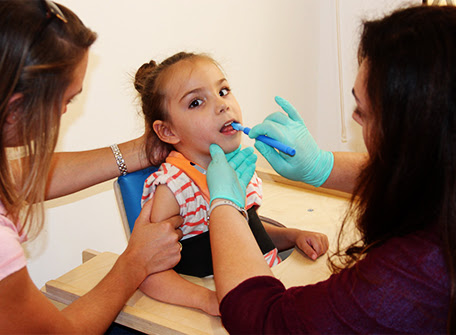Browsing the Course to Effective Feeding: Cutting-edge Methods and Treatments for Reliable Feeding Therapy
Are you battling to find reliable strategies and treatments for effective feeding therapy? Look no more. This short article will guide you through the course to success, offering innovative strategies to analyze feeding difficulties and established possible goals. With evidence-based techniques, you'll discover just how to address sensory processing problems and use assistive modern technology and adaptive devices. And also, we'll reveal you the importance of teaming up with families and caretakers for ideal feeding results. Prepare to browse the path to successful feeding!
Assessing Feeding Obstacles and Identifying Goals
You ought to start by assessing your kid's feeding challenges and recognizing specific objectives for their therapy. This action is critical in developing an efficient feeding treatment strategy. Begin by observing your youngster's feeding habits and patterns. Seek any aversions or troubles they might have towards specific foods or structures. Make note of any kind of sensory or physical issues that might be affecting their capability to eat. Once you have determined these difficulties, you can then set specific objectives for their treatment. These goals ought to be possible and sensible, focusing on boosting your kid's feeding abilities and general nourishment. You may establish a goal for your youngster to be able to tolerate a broader variety of appearances or to self-feed with utensils. It is very important to interact these goals with your kid's feeding therapist so they can customize the therapy sessions to address these details difficulties. By evaluating your youngster's feeding difficulties and establishing objectives, you are taking the initial step towards assisting them create successful feeding skills.
Applying Evidence-Based Techniques for Feeding Treatment
Implementing evidence-based approaches for feeding treatment can lead to positive results for kids. You are making sure that the treatments made use of are sustained by clinical study and have actually been confirmed effective when you include these strategies right into your youngster's therapy strategy. This technique boosts the probability of success and assists attend to the certain feeding difficulties your child may be experiencing.
By following evidence-based strategies, you can give your youngster with the very best possible care and assistance. These techniques may consist of utilizing a variety of sensory experiences throughout nourishments, such as checking out different appearances and tastes, to motivate acceptance of brand-new foods. Furthermore, executing therapy techniques can help resolve fussy eating habits and advertise healthier eating patterns.
Another essential element of evidence-based feeding treatment is entailing the family members in the therapy procedure. By supplying education and assistance to parents and caregivers, they can play an energetic role in aiding their youngster get rid of feeding difficulties. This joint technique improves the performance of therapy and advertises enduring positive adjustments in your youngster's eating practices.

Attending To Sensory Processing Issues in Feeding Therapy
Attending to sensory handling problems in feeding therapy can be challenging, but it is necessary for promoting a positive eating experience for youngsters. When you come across a youngster with sensory processing troubles throughout nourishment, it is vital to recognize that their reactions to certain textures, preferences, smells, and even audios are not willful (food therapist long island). By acknowledging and resolving these concerns, you can help develop an encouraging atmosphere that encourages healthy and balanced eating practices
One effective approach is to introduce brand-new foods slowly. Start with tiny, non-threatening parts and gradually boost the amount with time. This technique allows the kid to become accustomed to the food and its sensory buildings at their own rate. Furthermore, supplying a range of textures and flavors can aid desensitize their sensory system and broaden their food choices.
Involving the youngster in sensory play activities can likewise be beneficial. Motivate them to discover various appearances, such as squishing, squeezing, or touching various food products. This can aid normalize sensory input and minimize aversions to particular textures.
One more crucial facet is offering a organized and tranquil eating environment. Minimize diversions, such as bright lights or loud noises, which can overwhelm their detects and impede their capacity to concentrate on eating. Creating a predictable routine and utilizing aesthetic timetables can additionally aid the child feel more protected and in control throughout nourishment.

Using Assistive Innovation and Adaptive Equipment
Utilizing assistive technology and flexible devices can greatly boost the feeding experience for kids with sensory processing troubles. When you have check difficulty with sensory processing, nourishment can be tough and frustrating. However with the right tools, you can make it a more delightful and effective experience.
One choice is making use of specialized utensils and plates designed to fit your demands. These utensils may have textured handles or a larger grasp, making them simpler to hold and adjust. Plates with split areas can help separate various foods and prevent them from touching, which can be a source of discomfort for some youngsters.
In addition to specialized utensils and plates, there are additionally assistive devices that can be utilized throughout feeding. For instance, a weighted vest or lap pad can supply deep stress input, helping to soothe and control your sensory system. A vibrating toothbrush or chewable fashion jewelry can give oral sensory stimulation, making the act of eating a lot more delightful.
Technology can also play a function in improving the feeding experience. There are tools and applications available that can provide acoustic or aesthetic signs, such as timers or motivates, to help you stay focused and organized during mealtime.
Working Together With Family Members and Caretakers for Successful Feeding Outcomes
When working together with caretakers and families, you can collaborate to develop a nurturing and encouraging atmosphere for successful feeding results. By entailing family members and caretakers in the feeding treatment process, you can acquire important insights right into the youngster's feeding obstacles, behaviors, and choices. food aversion therapy long island. This browse around these guys cooperation permits an alternative method to feeding treatment, resolving not just the physical aspects but additionally the emotional and psychological elements that might affect a child's feeding capacities
One secret facet of working together with caretakers and families is giving education and training. By furnishing them with expertise and abilities, they can actively take part in the feeding therapy process and sustain the child's progression outside of treatment sessions. This can include teaching them feeding techniques, strategies for managing nourishment habits, and recognizing the value of uniformity and regimen in establishing healthy and balanced eating routines.
Furthermore, including family members and caregivers in objective setting and treatment preparation ensures that their point of views and objectives for the child are taken into consideration. By interacting, you can create sensible and possible goals that align with the family's values and concerns - food therapist farmingdale. This collaborative method promotes a feeling of possession and empowerment, developing a solid structure for successful feeding outcomes
In addition, normal and open interaction with caregivers and families is vital for efficient cooperation. By keeping recurring discussion, you can resolve concerns, provide support, and make required adjustments to the feeding therapy plan as needed. This communication also allows for sharing progress updates, celebrating achievements, and identifying any kind of obstacles or obstacles that might develop.

Conclusion
Congratulations on finishing this post on browsing the path to successful feeding! You have checked out various strategies and treatments for efficient feeding treatment, such as examining challenges, carrying out evidence-based techniques, resolving sensory processing concerns, and utilizing assistive innovation. By collaborating with caregivers and family members, you can ensure effective more information feeding end results. Remember to constantly remain proactive and cutting-edge in your strategy to feeding therapy. Keep up the magnum opus!
It's vital to connect these goals with your child's feeding therapist so they can tailor the therapy sessions to deal with these details obstacles.Applying evidence-based strategies for feeding therapy can lead to favorable outcomes for children.Addressing sensory processing issues in feeding therapy can be challenging, but it is important for promoting a positive eating experience for youngsters. By entailing family members and caretakers in the feeding therapy procedure, you can get important understandings right into the youngster's feeding preferences, habits, and obstacles. By equipping them with expertise and abilities, they can proactively get involved in the feeding treatment process and sustain the kid's progression outside of treatment sessions.